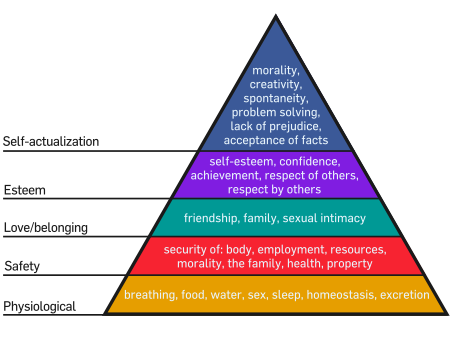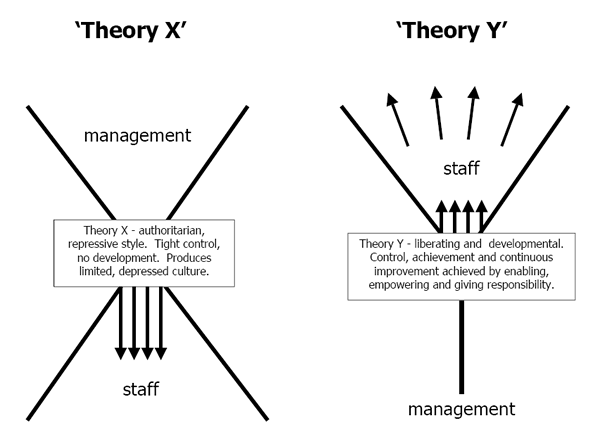Motivation is a personal experience based on goals, values, needs, and life experiences, and it is different for each individual. Even if a staff's skills and experience match the job perfectly, motivation is not guaranteed. Similar actions can reflect different motives and similar desires can result in different actions to achieve the motives. So, a manager cannot assume that they understand why a staff member is engaging in a particular activity.
Motivation Theories
- Content Theories- a way to measure staff in terms of "needs"
- Maslow's Theory of Motivation: humans are "wanting beings" and this "wanting" (or needs) is what motivates people. Our needs present themselves in a hierarchy, and we can only move from one level to the next (towards the top of the pyramid) when we meet all of the needs on one level. A satisfied need is not a motivator of behavior.
(Credit: Wikipedia)
- Process Theories- provide insight into how work is viewed and how "rewards" motivate people
- McGregor's Theory X and Theory Y: the traditional organization operates on a set of assumptions about human nature and motivations. Managers who use Theory X set up rigid structures that closely monitor employees, while those who use Theory Y allow employees to accomplish objectives they are committed to.
(Credit: Research-methodology.net)
- Reinforcement Theories- offer guidance in understanding the way that people learn patterns of behavior when behaviors are reinforced by their enviornment
- Positive reinforcement requires:
- identifying the desired behavior
- maintaining a variety of rewards
- recognizing staff differences in what is considered a reward
- providing the rewards immediately after the behavior
- Negative reinforcement requires:
- telling the person what is wrong with what they are doing
- telling the person how to correct it
- do it in private
- do it immediately after the behavior occurs
- make sure the negative reinforcement is appropriate to the severity of the behavior
Motivational Guidelines:
- make sure everyone knows and understands the expectations
- give directions and monitor progress
- give people the tools they need to succeed
- provide opportunities for learning and growth of skills
- praise good work, being specific about good preformances
- listen to your staff; consider the ideas they offer and really hear what they say
- keep the mission central to the organization and make sure everyone supports the mission (which will encourage pride in their own work)
- encourage social support among employees
I have seen many staff members whose actions were misinterpreted both negatively and positively. One of my circulation supervisors assumed that because one tech services person always volunteered to shelve in the stacks that she was a team players. The rest of us knew that she did it to talk on the phone in the stacks. When she came back, she would have a full cart of unshelved books which would get lost among the others. On the other hand, another person volunteered to help out in the cataloging services to process new books because she had a genuine interest. Unfortunately, these two people were seen as equally "good team players."
We have had a big problem recently at work with motivation. Because of our lack of staffing, a lot of people have been having to do a lot of extra work and our administration hasn't been very good at recognizing the amount of work that people are doing. I think that recognition is one of the biggest motivators.




The Maslow pyramid brings back memories of undergrad...nice to know it is still relevant. Thanks for finding it and including in your blog postings.
ReplyDeleteamy
sure! thanks for the comments!
ReplyDelete
ReplyDeleteI think this is an informative post and knowledgeable. I would like to thank you for the efforts you have made in writing this article
packers and movers in patna